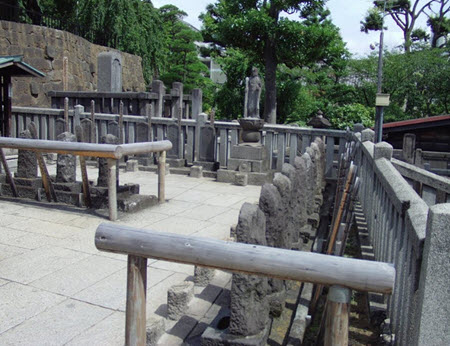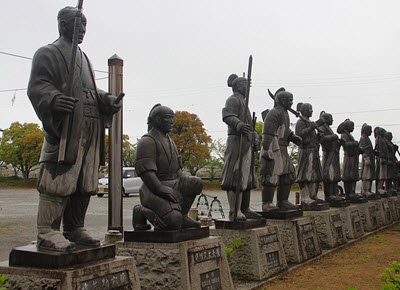On this page, you can learn more about what happened once the ronin had taken Kira’s head to their master’s tomb and turned themselves in to the autorities.
Sentencing and death

The garves of the 47 ronin at Sengaku-ji temple
When the 46 ronin had turned themselves in, the shogun had a difficult situation on his hands. They had disobeyed his orders, and murdered a court official, and must therefore be sentenced to death. But at the same time, they had followed the samurai code of loyalty by avenging their lord. The story about the brave ronin had spread like wildfire, and the shogun had already received several petitions from people who supported the actions of the loyal and self-sacrificing ronin.
Eventuality, the shogun reached a compromise. The ronin had to die, but instead of having them executed as criminals he ordered them to committ seppuku – a much more honarable death.
All the 46 ronin committed seppuku on 4 February, 1703. (Genroku 16, 4th day of the 2nd month) This included the young Chikara, who had just turned 16. They are interred on the grounds of Sengaku-ji, in front of their master’s tomb.
When Terasaka Kichiemon eventually returned to the capital, he was pardoned by the shogun. Exactly why remains unclear. When he finally died of old age, 87 years old, he was buried with the other 46 ronin.
Aftermath
After Asano’s attack on a court official in 1701, many of people who used to work for him and his family went through rough times. Since they had served under a now discraced family, it was difficult for them to find anyone willing to employ them. This included Asano’s former 300+ samurais, who had become ronin (masterless) upon his death and couldn’t find any other lord willing to emply them and turn them back into samurais. When the 47 ronin avenged Asano, and turned themselves in to the autorities, it (somewhat paradoxaly) improved the situation for the remaining ronin.
The situation also improved for Asano’s family, because the shogun allowed Asano’s younger brother and heir Asano Daigaku Nagahiro to re-establish his name and get some land back. The new territory was roughly 10% of the old territory.
Criticism
 The 47 ronin spent a lot of time waiting for Kira to relax his security after the death of Asano, since they wanted their attack on him to be successful. In the mean time, they did everything they could to seem like they had no interest at all in avenging their master.
The 47 ronin spent a lot of time waiting for Kira to relax his security after the death of Asano, since they wanted their attack on him to be successful. In the mean time, they did everything they could to seem like they had no interest at all in avenging their master.
This waiting game was criticised by Yamamoto Tsunetomo, a samurai of the Saga Domain who lived 1659-1719. He asked “What if, nine months after Asano’s death, Kira had died of an illness?”
Yamamoto pointed out that if Kira had died from other causes while the ronin waited, they would have lost their chance to avenge their master, and if they would have revealed their plan after Kira’s untimely death, claiming that their decadent behaviour was just an act, few would have believed them. Instead, they would have been remembered as cowards and drunkards, and this would have been shameful for the Asano clan.
According to Yamamoto, Ōishi was obsessed with success, and was willing to risk dishonoring the name of his clan – the worst sin a samurai can commit – just to improve the ronin’s chances of killing Kira. According to Yamamoto, the ronin should have attacked Kira right after Asano’s death. They would probably have failed to kill Kira, but this didn’t matter – the important thing was honoring the Asano clan, and for the former samurai to show outstanding courage and determination to win everlasting honor for their dead master.
